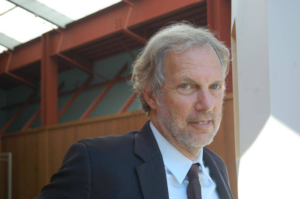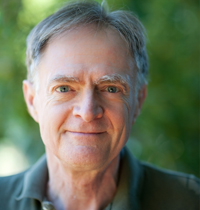
Robert Pollin
The energy transition from fossil-based systems of energy production and consumption to renewable energy sources is moving slowly, and scores of global conferences on climate change over the past few decades have failed to produce the desired results. From the look of things, fossil fuels are going to be around for a long time to come, even though there is undeniable evidence that humanity is moving, as economist Robert Pollin puts it, “relentlessly towards a climate abyss.”
But even so, the Green New Deal and the fight for a more sustainable future are anything but dead, argues Pollin, one of the world’s leading progressive economists. In the exclusive interview for Truthout that follows, Pollin argues that there are many positive developments here in the U.S., as well as in Europe and other parts of the world, to suggest that the fight against climate change is not yet lost. Pollin is distinguished university professor of economics and co-director of the Political Economy Research Institute (PERI) at the University of Massachusetts Amherst. He is the author or co-author of a large number of books and academic articles, including Climate Crisis and the Global Green New Deal (with Noam Chomsky and C.J. Polychroniou, 2020) as well as major green economy transition programs for several U.S. states (including California, Maine New York, Ohio, Pennsylvania, Colorado, Washington and West Virginia) and different countries, including the U.S., India, South Korea, Spain, Brazil, South Africa, and Indonesia.
C. J. Polychroniou: Bob, we seem to be losing the fight against global warming. 2022 has been described as “the year the energy transition went off the rails” as carbon emissions from fossil fuels last year are projected to hit record high and the Copernicus Climate Change Service said that summer 2022 was Europe’s hottest on record, causing over 20,000 excess deaths. Meanwhile, another global climate conference (COP 27) ended with no progress on fossil fuels. Why do fossil fuels continue to remain essential to the global economy, and why does the energy transition appear to be proceeding at a snail’s pace?
Robert Pollin: To begin with, I don’t think the current status of the fight against global warming is quite as bleak as the Forbes Magazine headline you are quoting conveys. Of course, there is a great deal of evidence demonstrating that we continue to move relentlessly toward a climate abyss. And yet, some significant positive countertendencies have also emerged over the past year. These countertendencies are not yet nearly adequate to move us onto a viable climate stabilization path. But we still need to embrace these developments so that we can build effectively from them.
But let’s start by recognizing some grim realities. Here are a few indicators from the World Meteorological Organization’s 2022 report, “Provisional State of the Global Climate”:
– Concentrations of the three main greenhouse gases — carbon dioxide, methane and nitrous oxide — reached record highs in 2021, with preliminary evidence finding that this upward trend continued in 2022.
– The average global temperatures for 2015-2022 are likely to have been the eight warmest years on record.
– The temperature in the U.K. reached 105° Fahrenheit for the first time on record, while three states in Germany experienced their driest summer on record.
– Average daily temperatures were sustained at over 110° F during the heat wave in India this past May, while monsoon flooding in Pakistan in July and August inundated about 9 percent of the country’s total land area.
A Washington Post article from last July titled “India’s Deadly Heatwave Will Soon Be a Global Reality” reported that,
“As the climate warms, conditions once experienced only in saunas and deep mineshafts are rapidly becoming the open-air reality for hundreds of millions of people, who have no escape to air conditioning or cooler climes. After a few hours with humid heat above 95° F — a measure known as the wet-bulb temperature — even healthy people with unlimited shade and water will die of heatstroke. For those carrying out physical labor, the threshold is closer to 88° F or even lower.”
By far, the major driver of rising global temperatures is burning fossil fuels — oil, coal and natural gas — to produce energy. Therefore, the first and most important task for fighting global warming must be, simply, to stop burning oil, coal and natural gas to produce energy. Forbes is correct that 2022 brought a series of devastating setbacks on this front. To begin with, Russia’s invasion of Ukraine led to oil and gas supply shortages, especially in Europe, which is heavily dependent on Russian supplies. These supply shortages enabled the oil giants to jack up prices and reap unprecedented profits. In fact, as has been widely reported, the six largest Western oil companies — ExxonMobil, Chevron, Shell, BP, Equinor and Total — made $200 billion in profits in 2022, more than any previous year in the history of the industry.
The oil companies, in other words, are feasting as the world burns. Should we be surprised that Wall Street has registered its strong approval? Thus, the Financial Times reported that, “U.S. giant ExxonMobil, which has resisted pressure to decarbonize more than any other energy major, increased production in 2022 and its shares rallied more than 50 percent in the year as it raked in a record $55.7 billion in profits.” Then there is the case of BP, the oil major that had previously gone the furthest in its commitments to decarbonize. But those commitments went out the window in the face of exploding profit opportunities. The Financial Timesnoted that this decision “stirred anger from environmentalists … yet the market approved. BP’s shares rallied more than 10 percent over the following 48 hours, reaching their highest level in 3 ½ years.”
Coal was also revived in 2022. This was due in part to the natural gas shortages created in Europe by the Ukraine war. But the largest increases in coal consumption were not due to the war, but rather to the continued increases in consumption in India and especially China. China now accounts for about 50 percent of all global coal consumption.
These developments led Chevron’s chief executive Mike Wirth to triumphantly pronounce that, “The reality is [fossil fuel] is what runs the world today. It’s going to run the world tomorrow and five years from now, 10 years from now, 20 years from now.” What if Wirth is correct? Then we are certainly moving closer to the climate abyss exactly in step with the Mike Wirths of the world engorging themselves on fossil fuel profits.
Amid this, where can we possibly also see significant positive developments? We can start in the U.S., with the enactment of the Inflation Reduction Act (IRA) last August. The law is deliberately misnamed. It is mostly a measure to channel large-scale financing into clean energy investments. But the Biden administration couldn’t openly advertise this fact without losing the support of West Virginia Sen. Joe Manchin. In any case, as a result of the IRA passing, clean energy investments immediately spiked in the last three months of 2022 to $40 billion, equal to the total level of such investments for all of 2021. Moreover, most of this new investment money has been flowing into Republican-dominated states, where, as the Wall Street Journal pointed out, not a single Republican member of Congress voted for the law. Still more, a large percentage of the new jobs being created by these investments, including in the Republican-dominated states, are reserved for union members.
In short, a fundamental new reality could be emerging out of the IRA: that working people will begin to see how the green energy transformation can be a major engine for creating good union jobs, in red states just as much as in blue states. This is a central idea behind the Green New Deal, as has been advanced in the U.S. for over a decade by excellent groups like Labor Network for Sustainability, the BlueGreen Alliance and Reimagine Appalachia. If this point does become broadly recognized, it could deliver unprecedented levels of support for a global Green New Deal. For example, it would mean that, as opposed to the Yellow Vest movement that emerged in France in 2018 insisting that economic justice be prioritized over climate justice, the global Green New Deal will be understood as the means through which economic justice and climate justice movements can become unified.
There have also been major positive developments in Europe over the past year, which responded to the collapse of Russian oil and gas supplies by sharply increasing energy conservation measures and accelerating the roll-out of solar, wind, and other renewables. Thus, in 2022 for the first time, solar and wind power combined generated more electricity in Europe than either coal or gas. Going further, the European Commission enacted its REPowerEU program after Russia’s invasion. Its goal is “a massive scale-up of renewables, as well as faster electrification and replacement of fossil-based heat and fuel in industry, buildings, and the transport sector.” The target is for renewables to supply 45 percent of all energy in Europe by 2030. That would mean more than doubling the current 22 percent renewable share of overall energy supply in only 6 ½ years.
It is not clear that these goals will be actually achieved. To date, the level of EU funding behind REPowerEU does not match the rhetoric, at only about 0.2 percent of EU GDP annually through 2027. But here again, the point should become increasingly evident throughout Europe that the green energy transformation will be an engine for expanding job opportunities and raising working-class living standards — in other words, a clear alternative to the austerity economics that dominates in Europe today. As this point sinks in, the level of political support for funding REPowerEU at much higher levels could also grow correspondingly.
The election of Luiz Inácio Lula da Silva in October, returning him to the presidency of Brazil, was unquestionably a third major positive development over the past year. Lula’s predecessor, Jair Bolsonaro, was hell-bent on razing the Amazon rainforest to make room for corporate agriculture and mining. Aside from burning fossil fuels for energy, deforestation is the most significant force causing climate change. Lula is committed to stopping deforestation and protecting the Amazon. But it is also true that Lula’s commitments on this issue will be tested, for the simple reason that big profits can be made from destroying the rainforest.
Lula’s election victory needs to now be buttressed by large increases in financial support for forest protection in Brazil and elsewhere, and more generally, for Green New Deal projects in the Global South. This hasn’t happened so far, despite pledges made by rich countries at the most recent November climate summit in Egypt. In short, Lula’s victory, as well as the rapid scaling up of clean energy investments and jobs in the U.S. and Europe, need to be embraced as major positive developments. But we still have far to go in defeating the ongoing corporate project of destroying the planet in the name of profits.
There is growing emphasis on the need for adaptation strategies to reduce the adverse effects of global warming. Shouldn’t there be concern with shifting the climate policy focus from mitigation to adaptation?
Large-scale climate adaptation investments are an absolute imperative. Let’s come back to the brutal heat wave last spring in India. One obvious way to protect people during heat waves is with air conditioning. However, only 8 percent of Indian households now own air conditioning units. The situation in most of the rest of the world is not that different than India. The climate crisis has made access to air conditioning — along with cheap electricity generated by renewable energy sources to power the units — a necessity.
More generally, the global Green New Deal must incorporate a range of robust protections against climate change impacts. This includes greatly expanding available storage facilities for food, seed and fresh water, and ensuring that these structures are themselves strongly protected against climate events. It must also include water demand management infrastructure, including — where they can be introduced without damaging local ecologies — sea walls, dams, pumping capacity, permeable pavements and abundant water-buffeting vegetation. Existing buildings in vulnerable areas should be retrofitted to incorporate protective walls and green roofs to deal with both rainwater and heat. New buildings in vulnerable areas should be built with higher foundations or on stilts. Organic farming also provides important benefits in terms of climate protection. This is because organic farming is more effective than industrial agriculture in retaining the available water supply, using that water more efficiently, as well as mitigating soil erosion. Crop yields are also higher through organic farming under drought conditions and other forms of stress.
In addition to all these and other forms of physical protections, people and communities need to have access to effective and affordable financial insurance against climate change damage. More generally, protecting people against the worst effects of climate change will cost money. But this doesn’t mean that funding for adaptation should be seen as competing with funding for mitigation. Both are absolute necessities. It’s also not as if there is no money to be found. In addition to Big Oil’s record-shattering profits in 2022, global fossil fuel subsides also doubled, from roughly $500 billion to $1 trillion in 2022. This spike in fossil fuel subsides came after the 2021 Glasgow Climate Pact committed to phasing out these subsidies. Both mitigation and adaptation investments will more than pay for themselves over time, by protecting both the workforce, the physical infrastructure and the food and water supply, by expanding job opportunities, and by delivering cheaper and more reliable energy. All of this is in addition, of course, to providing the only humane course of action in the face of the climate crisis.
There is increasing concern among conservationists that the fight against global warming to save the planet is treating climate change apart from the broader ecological footprint. For example, it is contested that climate change is not the principal driver of biodiversity loss. Can global warming and biodiversity be tackled together?
Global warming and biodiversity loss can certainly be tackled together to a significant extent, even while there is not a one-for-one overlap between them in terms of either causes or solutions. The single biggest driver of biodiversity loss is land use change. This includes the destruction of animal habitats through deforestation and related human encroachments, as well as the disruption of the remaining habitats through the increasing frequency and severity of heat waves, droughts and floods. More generally, a 2018 study by the Intergovernmental Panel on Climate Change (IPCC) found that two degrees Celsius of warming would risk “shifts of species to higher latitudes, damage to ecosystems (e.g., coral reefs, and mangroves, seagrass and other wetland ecosystems), loss of fisheries productivity (at low latitudes) and changes to ocean chemistry (e.g., acidification … and dead zones.” The ecologist Pamela McElwee further notes that “if we reach the 2° C threshold, it is projected that 18 percent of insects, 16 percent of plants, and 8 percent of vertebrate species will lose over half of their geographic range, and localized extinctions are a near certainty.” The solution here is straightforward: do not allow global warming to cross the 2° C threshold or, for that matter, the more stringent 1.5° C threshold that the IPCC now insists is necessary.
But it is also the case that, as a 2021 IPCC study emphasized, “technology-based measures that are effective for climate change mitigation can pose serious threats to biodiversity.” For example, this IPCC study describes how the increased demand for minerals needed for wind turbines, solar panels, electric car motors and batteries can produce serious negative impacts on land areas as well as oceans, to the extent that seabed mining becomes a major new source of mineral supplies. Some solutions here are at once obvious but difficult to achieve. They include greatly expanding the system of recycling the minerals where demand is growing, developing technologies in the renewable energy sectors in which mineral requirements are less intensive, as well as insisting on strong environmental and social sustainability requirements in mining operations.
In other words, the challenges of advancing an effective unified framework for addressing both climate change and biodiversity loss are formidable. But we simply have no alternative other than continuing to build the movement that is capable of meeting these challenges.
This interview has been lightly edited for clarity.
Source: https://truthout.org/
C.J. Polychroniou is a political scientist/political economist, author, and journalist who has taught and worked in numerous universities and research centers in Europe and the United States. Currently, his main research interests are in U.S. politics and the political economy of the United States, European economic integration, globalization, climate change and environmental economics, and the deconstruction of neoliberalism’s politico-economic project. He is a regular contributor to Truthout as well as a member of Truthout’s Public Intellectual Project. He has published scores of books and over 1,000 articles which have appeared in a variety of journals, magazines, newspapers and popular news websites. Many of his publications have been translated into a multitude of different languages, including Arabic, Chinese, Croatian, Dutch, French, German, Greek, Italian, Japanese, Portuguese, Russian, Spanish and Turkish. His latest books are Optimism Over Despair: Noam Chomsky On Capitalism, Empire, and Social Change (2017); Climate Crisis and the Global Green New Deal: The Political Economy of Saving the Planet (with Noam Chomsky and Robert Pollin as primary authors, 2020); The Precipice: Neoliberalism, the Pandemic, and the Urgent Need for Radical Change (an anthology of interviews with Noam Chomsky, 2021); and Economics and the Left: Interviews with Progressive Economists (2021).
 In a remarkable new study, the broad-brush patterns between how we use and mark public space and our collective well-being were investigated in 2022 by Quynh C. Yue and colleagues who analyzed 164 million Google Street View images from locations across the United States. The study extracted information on the built environment with a focus on the directionality of traffic, the incidence of crosswalks and sidewalks, and the presence or absence of street signs, which foster way-finding. The information collected on the built environment was then compared with census-tract, health information for those neighborhoods that were included in the Google Street Views.
In a remarkable new study, the broad-brush patterns between how we use and mark public space and our collective well-being were investigated in 2022 by Quynh C. Yue and colleagues who analyzed 164 million Google Street View images from locations across the United States. The study extracted information on the built environment with a focus on the directionality of traffic, the incidence of crosswalks and sidewalks, and the presence or absence of street signs, which foster way-finding. The information collected on the built environment was then compared with census-tract, health information for those neighborhoods that were included in the Google Street Views.



